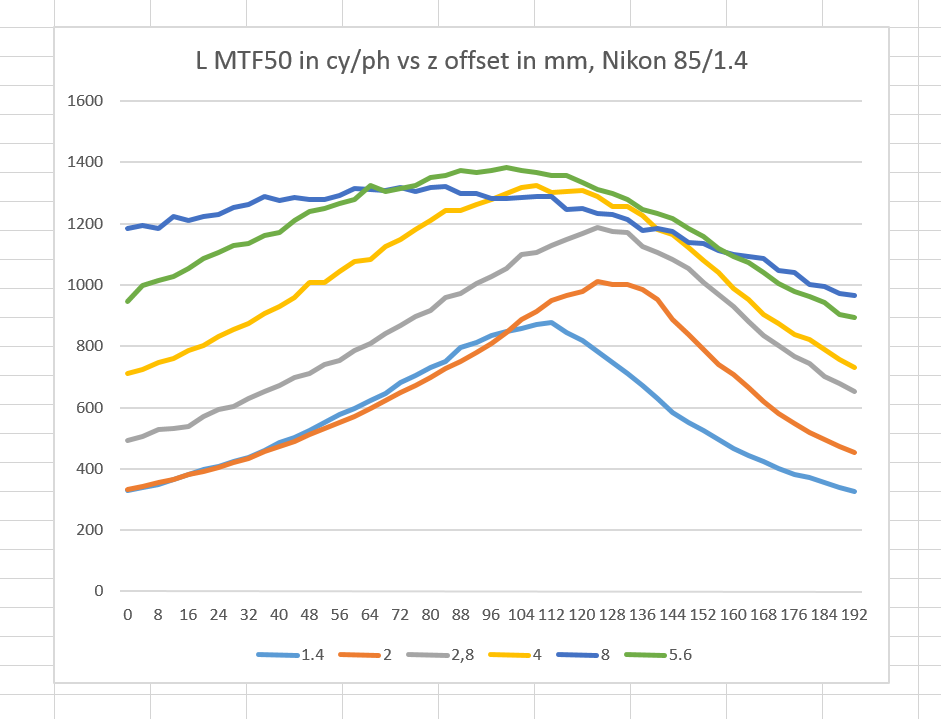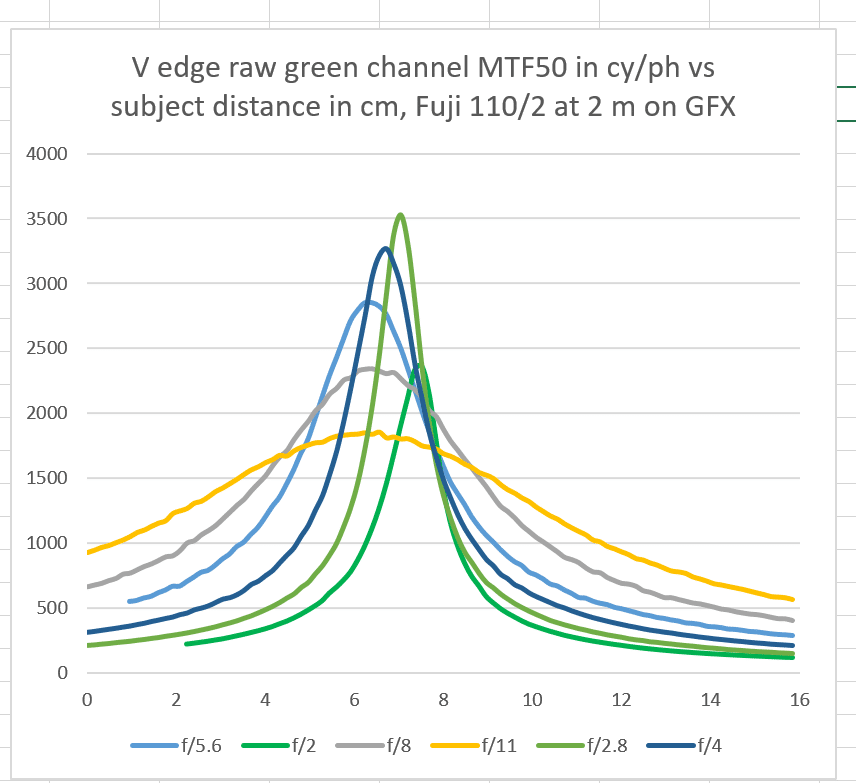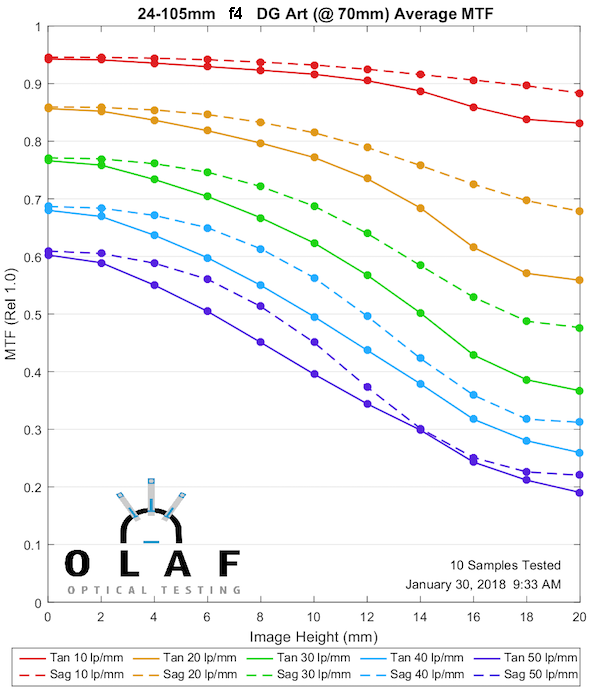Hi Bernard,
The Phase One IQ3100 is hardly a small sensor camera, it's sensor size 54x40 mm, approximately, having a pixel size around 4.6 microns. That is the camera at the top left, giving the cleanest detail.
It is a well known fact that contrast at the pixel level needs to be reasonably low, say under 10% to avoid artefacts.
Below is a plot of measured MTF of a Planar 100/3.5CF lens on a P45+ back compared with a Sony 90/2.8G lens on a Sony A7rII.
The P45+ back resolves 73 lp/mm. It's pixel size is 6.8 microns, while the Sony is at 4.5 microns, resolving 110 lp/mm. The contrast at Nyquist is significant perhaps 27% on P45+ and around 20% on the Sony. Pixel size on the Sony is similar to the IQ3100.
The image belows shows MTF values up to 300 lp/mm on the Otus 85/1.4 at f/2.0. It is probably a bit better of axis at f/4.
MTF data at 60 lp/mm is not that frequently available, but lens rentals tests down to 50 lp/mm, this is from OLAF Optical Testing's latest test on the Sigma 24-105/4 Art at 70 mm and full aperture, it has over 40% MTF over a large part of the image at 50 lp/mm. So even a decent quality standard zoom can deliver decent MTF at 50 lp/mm and in all probability also at 60 lp/mm.
So the figures you are discussing at 30 and 60 lp/mm is not really relevant. Here is where cameras operate:
Phase One IQ100MP -> 108 lp/mm
Hasselblad X1D -> 93 lp/mm
Leica S -> 83 lp/mm
P45+ (39MP 49x37mm) -> 73 lp/mm
Sony A7rII -> 110 lp/mm
APS-C at 24 MP -> 125 lp/mm
Now, let's do a small experiment. We shoot a one Dollar bill at around 4m distance with an 80 mm lens on the P45+, we get the following image:
Next we shoot the same one Dollar at the same distance with an APS-C camera, having 24 MP and still using an 80 mm lens. The reason we do this is not to compare resolution between the two formats, just to see the effect of pixel size. The resulting image of the one Dollar bill will be larger, so we downsize it to the same size:
The smaller pixels yield a much cleaner image.
Now, we can take the P45+ image again, but shoot at f/16, so we let diffraction reduce contrast at Nyquist to near zero, and apply aggressive sharpening:
Brandon Dube works for different labs, including OLAF Optical Testing and also works on optical simulation for NASA. Brandon has a very nice article about the effects lens and pixel parameters on 8K television images. 8K is around 42MP, but this time it is extracted from an APS-C size sensor.
Here is Brandon's article:
https://www.lensrentals.com/blog/2017/10/the-8k-conundrum-when-bad-lenses-mount-good-sensors/
Just to say, NHK (Japanese television) has a 133 MP sensor in approximately 24x36 mm size (43 mm diagonal but 16:9 aspect ratio) with a complete RGBG quartet for each image pixel. It was developed by Forza Semiconductor. It will be used for the Tokyo Olympic Games.
Please realize that much research has been done on image quality. I would also make the subtle point that I own and have been using a P45+ back for something like 4.5 years, so I have experience large sensor cameras.
Best regards
Erik Kaffehr
The main benefit of having a larger sensor is that we get more micro-contrast, simply because we are using the lens higher-up in its MTF curve. A small sensor with 40 MP shows a lens's performance deep in the MTF curve (60lp/mm or more). Contrast at that level is nearly nil. If you use a larger sensor with the same number of pixels, then you are operating in a much more comfortable range (say 30 lp/mm) where contrast is higher.
You can't see micro-contrast at extreme magnifications, especially with targets like printed text. All you are testing is the de-bayering algorithm. If you can see this type of false colour in a print, it means that you are printing too big. Or standing too close.
I am always weary of "tests" that claim to show that a small sensor camera is "just as good" as a larger sensor camera with the same number of pixels. The argument always comes down to the fact that the images look similar when you zoom-in to 400% or more. They both look terrible...
I've done tests with prints, and people always point-out that the medium-format shot looks "more real" or"three dimensional." That's because fine detail is rendered at 50 or 60% contrast, rather than 20% contrast. Skin looks more natural, tonal transitions are smoother, textures look more like they do in real life.
This isn't a new theory. There's a famous Zeiss paper from the 1960s or 70s that says essentially the same thing. Their main conclusion is that micro-contrast is a better determinant of image quality than resolution, and therefore that photographic lenses should be optimized for contrast rather than ultimate resolution (other factors come into play for microscopes, and for microfilm lenses).










